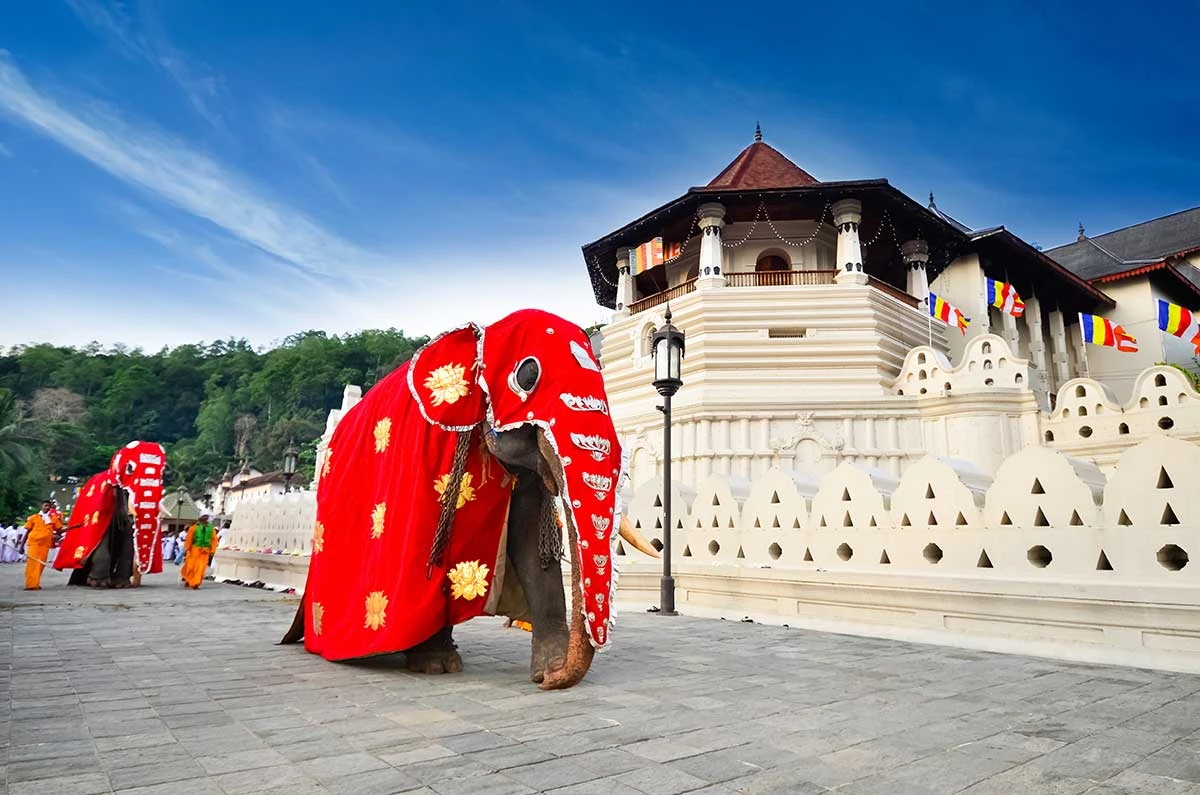The temple of the sacramental tooth, or Sri Dalada Maligawa, is one of the holiest places of worship in Sri Lanka and a UNESCO world site. The temple is the sacred place in Kandy which is centrally located and has provided homes to the sacred tooth relic of Lord Buddha and hence its a pilgrimage place highly watched by the Buddhist communities over the rest of the world.
History and Significance of Sri Dalada Maligawa
The Temple of the Sacred Tooth Relic is a historical place where traditions of the past touched the history more than 1,600 years ago. Princess Hemamali and Prince Dantha of Kalinga, India had brought the sacred tooth relic into Sri Lanka in 310 C.E according to Buddhist tradition. The relic nowadays has been believed to be the most valuable item of the Sinhalese race and the mark of sovereignty.
The Odyssey of the Sacred Tooth Relic
The history of the Buddhist legacy in the island can be traced with the advent of tooth relic in the ancient capitals of Sri Lanka:
- Anuradhapura Period (310-1017 CE): The relic, in the first place, was enshrined at Anuradhapura, the ancient capital
- Polonnaruwa Era (1017-1235 CE): During medieval times immigrated to Polonnaruwa
- Gampola and Kotte Periods (1235-1592 CE): Shifted it several times because of invasions
- Kandy Kingdom (1592-1815 CE): At long last rooted in Kandy where the kingdom still exists to date
Architecture and Design of the Dalada Maligawa
The traditional Kandyan architecture is displayed in the present temple structure with individual expansion and reconstruction. The complex is full of excellent craftsmanship and artistic brilliance of Kandyan stand.
Important Architectural Features
Main Temple Building: The octagonal building is built in two stories with sacred relic chamber. The upper level holds the tooth relic while the lower floor is a shrine room to the devotees.
The Pattiripuwa: It is a special octagonal pavilion of royal addition by the king Sri Vikrama Rajasinha and the main entrance of the relic chamber. This is one of the most photographed structures of the temple because of its amazing architecture.
Audience Hall: It is a wooden building with highly detailed carvings built initially as a part of the royal palace which now acts as a ceremonial building in the case of major Buddhist festivals.
The Royal Palace Complex: neighbor to the temple is the old royal headquarters that houses the national museum of kandy where you can find artifacts of the Kandyan Kingdom.
The Sacred Tooth Relic: Buddhist Significance
The tooth relic of Lord Buddha holds immense spiritual significance in Theravada Buddhism. Buddhists believe that possessing this relic brings prosperity and protection to the nation. The relic is housed in seven golden caskets, nested one within another, and is rarely displayed to the public.
Daily Rituals and Ceremonies
The temple follows strict daily rituals that have been maintained for centuries:
- Dawn Ceremony (4:30 AM): The first of three daily pujas
- Midday Ceremony (10:30 AM): The second puja with offerings
- Evening Ceremony (6:30 PM): The most elaborate ritual with traditional drumming
The Esala Perahera: Sri Lanka's Greatest Festival
Sri Lanka is also visited by the most spectacular Buddhist festival of Sri Lanka known as Esala Perahera that is observed annually during July or August. The culmination of this ten days celebration is a splendid procession that is made up of:
- Conventional Dancers: Kandyan dancers, fire dancers and stilt walkers
- Decorated Elephants: More than 100 elephants are involved, and the sacred casket is brought on the foremost elephant
- Cultural Performances: Traditional music, drumming and folk performances
- Religious services: Special prayers and blessings are carried out by Buddhist monks
Before you go on Perahera Planning Your Visit
The Esala Perahera gathers thousands of tourists around the world. There is what you are to know:
- Best Observation Points: Pre book a seat on the procession route
- Lodging: Hotels become booked in a short period; reserve several months in advance
- Culture: The festival is a blend between Buddhist and cultural heritage
- Photography: Enormous possibilities of cultural photography
Visiting Sri Dalada Maligawa: Complete Guide
Opening Hours and Entry Requirements
- Daily Hours: 5:30 AM to 8:00 PM
- Entry Fee: Varies for locals and foreigners
- Dress Code: Conservative clothing required; shoulders and knees must be covered
- Photography: Limited photography allowed; flash photography prohibited
What to Expect During Your Visit
- Security Procedures: All visitors undergo security screening before entering the temple premises.
- Guided Tours: Professional guides available in multiple languages to explain the temple's history and significance.
- Museum Visits: The temple museum displays historical artifacts, paintings, and cultural items related to the tooth relic and Kandyan Kingdom.
Best Times to Visit
- Early Morning (5:30-7:00 AM): Fewer crowds, peaceful atmosphere
- Evening Ceremony (6:30 PM): Most atmospheric time with traditional rituals
- Avoid Full Moon Days: Extremely crowded with local devotees
- Weather Considerations: Kandy's cool climate makes year-round visits comfortable
Cultural and Religious Significance
The temple is not only a tourist attraction but reflects the whole Buddhist tradition and culture of Sri Lanka. The temple is:
Buddhist Seat of Learning
The temple has a religious community that comes in the form of monks who regard the traditional scriptures and teachings of Buddhism of the ancient times. Monks living here practice centuries-old traditions of meditation, chanting and religious teaching.
National Identity Representative
The relic of the tooth is regarded as a necessity in legitimacy through the course of Sri Lankan history. Rulers tried to get the blessing of the relic on themselves and the presence of the relic was considered a sort of divine permission to rule.
World Heritage UNESCO Recognition
In 1988, the Sacred City of Kandy together with the Dalada Maligawa were declared as a World Heritage Site by UNESCO due to its excellent universal value to humanity.
Planning Your Journey to Kandy
Getting to Sri Dalada Maligawa
From Colombo:
- By Train: Scenic 3-hour journey through tea plantations
- By Road: 3-hour drive via A1 highway
- By Air: Helicopter transfers available for luxury travelers
Local Transportation:
- Tuk-tuks: Convenient for short distances within Kandy
- Walking: The temple is centrally located and easily walkable
- Local Buses: Affordable option for budget travelers
Accommodation Options
- Luxury Hotels: Several high-end properties offer views of the temple and lake
- Mid-range Options: Comfortable guesthouses and boutique hotels in the city center
- Budget Accommodation: Backpacker hostels and family-run guesthouses available
Nearby Attractions and Activities
Kandy Lake (Bogambara Lake)
This artificial lake made by the last king of Kandy provides walks and wonderful sightseeing the temple. The surrounding of the lake offers great moment of photography; particularly at sunset.
Peradeniya Royal Botanical Gardens
These botanical gardens, known all over the world, are located 6 kilometers away Kandy where there are more than 4,000 kinds of plants grown here and there are rare orchids and large fields of bamboo.
Tea plantations and Factory
There are tea plantation hills around Kandy city. Tourists are allowed to visit operational tea factories and get to know about production of Ceylon tea.
Shopping and Traditional Crafts
Kandy has superb shopping of the traditional Sri Lankan crafts:
- Gems and Jewelry: Sri Lanka precious gems and antique designs
- Traditional handwoven textile: Traditional sarongs and materials
- Wood carvings: Finely made sculptures and ornamental pieces
- Spices: Original Ceylon Spices and varieties of tea
Conservation and Preservation Efforts
The Sri Dalada Maligawa continues to be challenging in terms of conservation because of its age, tropical climate and huge tourist footfall. There are ongoing conservation activities which consist of:
Structural Maintenance
The architectural value of the temple has been maintained and the historical authenticity kept intact by regular repair work. Repairs are done by skilled craftsmen by using traditional techniques and materials.
Artifact Preservation
Ancient scripts, paintings, and religious materials are preserved by climate control to keep them unaffected by damage. These treasures are recorded in digital archiving services that support the future generation.
Sustainable Tourism
There are plans of practicing responsible tourism which does not interfere with the sanctity of the temple, but also benefits the people living in the surrounding areas and conservation.
Tips for Respectful Visiting
Cultural Sensitivity
- Remove shoes: Before entering temple buildings
- Silent behavior: Maintain quiet, respectful demeanor
- Photography etiquette: Ask permission before photographing people
- Offerings: Follow local customs if making offerings
Supporting Local Communities
- Local Guides: Hire certified local guides to support the community
- Authentic Experiences: Choose locally-owned restaurants and shops
- Cultural Exchange: Engage respectfully with local people and traditions
Conclusion: Experience the Sacred Heart of Sri Lanka
The Sri Dalada Maligawa is one of the representations of the great Buddhist tradition and the cultural continuity of Sri Lanka. Besides being a tourist attraction site, this spiritual temple gives its tourists a deep spiritual encounter and a great insight into religious beliefs and customs of the island.
Be it the religious devotion, interest in history and culture, the Temple of the Sacred Tooth Relic will offer a memorable experience of the core of the Buddhism in Sri Lanka. Temple is built in the most exquisite architecture, it has a very mystical atmosphere, and you must see it during any trip to Sri Lanka.
To get the truest experience, pay your visit during one of the daily rituals, and you can visit during the Esala Perahera festival to experience a once in a lifetime cultural event. It is always good to remember that this is a living active place of worship and the old practices are still living in the contemporary world.
Take a trip to the Sri Dalada Maligawa that opens before you the door of a miraculous meeting of history, spirituality, and culture by revealing to you the eternal wisdom of Buddhism and the eternal religious belief of the Sri Lankan people.


